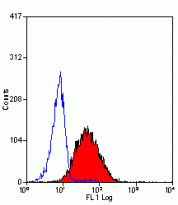ARG23127
anti-CD312 / EMR2 antibody [2A1] (PE)
anti-CD312 / EMR2 antibody [2A1] (PE) for Flow cytometry and Human
Overview
| Product Description | PE-conjugated Mouse Monoclonal antibody [2A1] recognizes CD312 / EMR2 Mouse anti Human CD312 antibody, clone 2A1 recognizes human EMR2, a member of the epidermal growth factor-seven transmembrane (EGF-TM7) family of proteins, which is closely related to CD97. EMR2, also known as CD312, is predominantly expressed on myeloid dendritic cells, monocytes and tissue macrophages. Various isoforms of EMR2 have been documented. The ligand for the largest isoform of EMR2 has recently been identified as chrondroitin sulphate, which binds to the fourth EGF-like module of EMR2. Clone 2A1 specifically recognizes the stalk region of EMR2. |
|---|---|
| Tested Reactivity | Hu |
| Tested Application | FACS |
| Host | Mouse |
| Clonality | Monoclonal |
| Clone | 2A1 |
| Isotype | IgG1 |
| Target Name | CD312 / EMR2 |
| Antigen Species | Human |
| Immunogen | NIH-3T3 cells stably transfected with EMR2 (EGF1-5) cDNA. |
| Conjugation | PE |
| Alternate Names | CD antigen CD312; EGF-like module-containing mucin-like hormone receptor-like 2; EMR2; CD312; Adhesion G protein-coupled receptor E2; EGF-like module receptor 2 |
Application Instructions
| Application Suggestion |
|
||||
|---|---|---|---|---|---|
| Application Note | FACS: Use 10 µl of the suggested working dilution to label 10^6 cells in 100 µl. * The dilutions indicate recommended starting dilutions and the optimal dilutions or concentrations should be determined by the scientist. |
Properties
| Form | Liquid |
|---|---|
| Purification | Purification with Protein A. |
| Buffer | PBS, 0.09% Sodium azide, 1% BSA and 5% Sucrose. |
| Preservative | 0.09% Sodium azide |
| Stabilizer | 1% BSA and 5% Sucrose |
| Storage Instruction | Aliquot and store in the dark at 2-8°C. Keep protected from prolonged exposure to light. Avoid repeated freeze/thaw cycles. Suggest spin the vial prior to opening. The antibody solution should be gently mixed before use. |
| Note | For laboratory research only, not for drug, diagnostic or other use. |
Bioinformation
| Database Links |
Swiss-port # Q9UHX3 Human Adhesion G protein-coupled receptor E2 |
|---|---|
| Gene Symbol | ADGRE2 |
| Gene Full Name | adhesion G protein-coupled receptor E2 |
| Background | This gene encodes a member of the class B seven-span transmembrane (TM7) subfamily of G-protein coupled receptors. These proteins are characterized by an extended extracellular region with a variable number of N-terminal epidermal growth factor-like domains coupled to a TM7 domain via a mucin-like spacer domain. The encoded protein is expressed mainly in myeloid cells where it promotes cell-cell adhesion through interaction with chondroitin sulfate chains. This gene is situated in a cluster of related genes on chromosome 19. Alternatively spliced transcript variants encoding multiple isoforms have been observed for this gene. [provided by RefSeq, Aug 2012] |
| Function | Cell surface receptor that binds to the chondroitin sulfate moiety of glycosaminoglycan chains and promotes cell attachment. Promotes granulocyte chemotaxis, degranulation and adhesion. In macrophages, promotes the release of inflammatory cytokines, including IL8 and TNF. Signals probably through G-proteins. [UniProt] |
| Calculated MW | 90 kDa |
| PTM | Autoproteolytically cleaved into 2 subunits, an extracellular alpha subunit and a seven-transmembrane beta subunit. [UniProt] |
Images (1) Click the Picture to Zoom In






